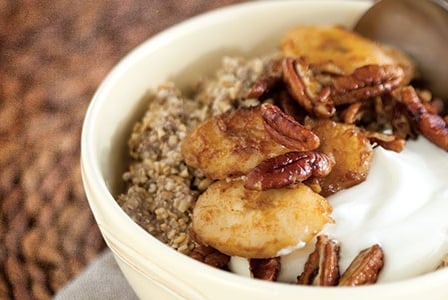
There\’s nothing like a soothing bowl of oats to warm up a winter morning. But we\’ve taken oats beyond brekkie to create healthy oats recipes for every meal.
In many ways oats are the Rodney Dangerfield of grains. They don’t get any respect. That’s because in all the hoopla surrounding quinoa, amaranth, and other supergrains, comforting oats have seemingly fallen out of favour with many. Yet, this healthy whole grain has some serious nutritional knockout capabilities.
Among its nutrient highlights are lofty amounts of phosphorus, thiamine, immune-boosting zinc, and magnesium. On top of its role in promoting healthy bones and immune function, a growing body of research suggests that the mineral magnesium is an ally in the battle against diabetes. Higher intakes of magnesium may improve insulin sensitivity.
And the rumours are true: oats are a champion for heart health. A large review of studies conducted by researchers at the University of Manitoba found that beta glucan, a soluble fibre present in oats, can help lower blood levels of total and LDL cholesterol, both of which are considered risk factors for heart disease. By slowing down rates of digestion and rises in blood sugar, a diet replete with high-fibre foods such as oats may also help slash diabetes risk.
Surprisingly, oats are also rich in disease-thwarting polyphenol antioxidants including avenanthramides. So whether it’s a soothing bowl of steamy oatmeal or a spirit-lifting homemade oatmeal cookie, there are plenty of reasons to once again embrace oats.
Improve performance and manage weight with oats
Once considered a homely ingredient, oats are becoming the go-to breakfast choice for all types of athletes. Oats are rich in oxygen-carrying iron and energy-releasing B vitamins, nutrients essential to peak athletic performance. Plus, they’re packed with soluble fibre, which is paramount to managing cholesterol levels and a healthy weight. This Bircher Chai Muesli also contains protein-rich pecans as well as bananas, which contain potassium, an electrolyte that we lose when we sweat.
Recipes
- Bircher Chai Muesli with Banana-Pecan Topping
- Baked Pumpkin Oatmeal with Blueberry Compote
- Warm Apple Cider Oat Smoothie
- Oat Salmon Loaf with Pomegranate Glaze
- Oat and Sweet Potato Salad
- Chocolate Oat Tart
Perfect oatmeal
Undeniably, steel-cut oats produce the most wholesome and delicious oatmeal. For best results, combine 1 cup (250 mL) steel-cut oats, 2 cups (500 mL) water, and 1 cup (250 mL) milk of choice in medium-sized saucepan. The milk produces creamier oatmeal. Bring to a boil, reduce heat to medium-low, and simmer uncovered until tender, about 20 minutes. To jazz things up, nuts, seeds, dried fruit, vanilla extract, and spices such as cinnamon can be stirred in toward the end of cooking.
Soaking your steel-cut oats overnight will shorten the cooking time by about half—a good weekday breakfast trick. To reheat leftovers, simply place cooked oatmeal in saucepan with some additional water or milk and heat over medium-low until warmed.
The word on gluten
Similar to quinoa and buckwheat, oats are naturally gluten free. However, because they are often a rotation crop with wheat, and processed in the same facilities, they can be contaminated with gluten.
Current government guidelines dictate that no oat-containing products can be labelled as “gluten free.” However, Health Canada recognizes that most people with celiac disease or gluten sensitivity can consume oats deemed to be pure and uncontaminated, which must contain no more than 20 parts per million of gluten. Still, those who respond poorly to gluten are urged to consult with their health care practitioner before consuming oats.
Oat guises
There are plenty of ways to get your oat fix. And unlike most other grains, the bran and germ of the oat remains after hulling, which makes the different types that much more nutritious.
Whole oats/groats
Like wheat, oats are a grass, the grain of which is referred to as the groat. This is why whole oats are often labelled “oat groats” in stores. These are the least processed form of oats available and can make a nutritionally charged addition to salads, soups, casseroles, and winter stews. Oat groats have a nutty flavour and slightly chewy texture.
Steel-cut oats
These are produced when the oat grain is passed through steel blades, cutting the whole oats into pellet-like pieces. Steel-cut oats produce oatmeal that is especially hearty, creamy, and chewy, making it well worth the wait.
Rolled/old-fashioned oats
These are made when oat groats are steamed and then passed through large rollers to flatten them, which cuts down on cooking time. They are the form of oats most often called for in baking recipes.
Quick-cook oats
Quick-cook oats are groats that have been cut into a few pieces before being steamed and rolled. This means they only take about five minutes to prepare. They can be used interchangeably with old-fashioned oats in recipes, but the latter will yield more texture.
Instant oats
When steamed oats are rolled even more thinly, the result is instant oats. Though much maligned, instant oats are considered a whole grain breakfast option. Where they fall apart, though, is the copious amount of sugar added to most brands. So if you want the convenience of instant oatmeal in the morning, select plain versions and add fresh fruit for a sweet kick.
Oat flour
This often overlooked whole grain flour is made by grinding up oat groats into a fine powder. It makes a stellar addition to pancakes, muffins, cakes, cookies, and brownies, resulting in a somewhat chewier texture. Because it lacks gluten, it can’t be substituted one to one for wheat flour in recipes that require gluten for rising.
To make your own oat flour, simply blend oat groats in a food processor or other grinder until finely ground. You’ll need about 1 1/4 cups (310 mL) oats to make 1 cup (250 mL) flour. Store oat flour in an airtight container in the fridge or freezer to prevent it from turning rancid, but bring it to room temperature before using.
Oat bran
Whole grains such as oats contain three parts: the endosperm, the germ, and the bran. So oat bran is the isolated bran portion. It’s especially abundant in fibre, with a 1/2 cup (125 mL) serving providing 7 g to help keep cholesterol numbers in check. You can use it to bolster the fibre levels of cereal, baked goods, smoothies, and even yogourt.



